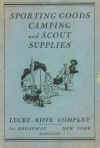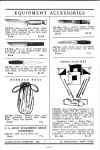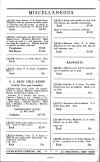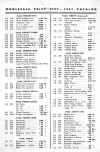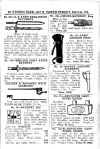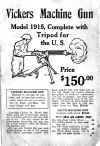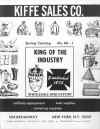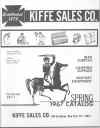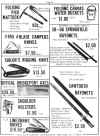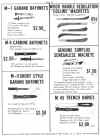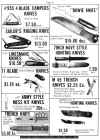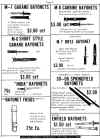Collecting Bayonets
by J.A. MaddoxNow that I have had time to read and study this book in some detail, I find that the author has succeeded admirably in the goal that he explains in the introduction. Dr. Maddox states that he wants to show rare and unusual bayonets, rather than the common items shown in most other bayonet books.
He says, in the introduction: "When one collector visits another to have a look at a bayonet collection, he generally doesn’t want to see the common stuff…he wants to see the rare and exotic items. He wants to see and feel the items that he doesn’t have, has never seen, or has only seen in pictures. I have tried to pack this volume with this "good stuff" for your education and entertainment." This book is indeed full of the rare and unusual from all over the world.
Although I personally have only limited interest in the bayonets from countries other than the US, I could not help marveling at the great variety of items of all type and from all time periods that are between these covers. Probably 25% of them I had never even heard of, and another 50% are bayonets that I may have known existed but had never seen personally. I was personally fascinated with the US trials and experimental bayonets shown, but any collector of any country’s bayonets will certainly find specimens in this book that he will find of great interest.
As such, and with the price being as high as it is, this book will primarily appeal to the more advanced and specialist collector. That is a real shame, because Dr. Maddox has also included sections that are of real value to the novice collector. These include sections on how to get started, terminology, how to display, cleaning, repair and restoration, and an in-depth bibliography of bayonet books. Although I found these sections of interest, they certainly would be more valuable to the newer collector than to the collector who would be more interested in the rare and unusual bayonets featured in the book.
As with any work, there are bound to be some errors or misstatements. I am not qualified to comment on most of the bayonets shown, but I do disagree with the designation on page 220 of the US M1942 Sword Bayonet. The M1942 is a collector designation only, the US Ordnance Department publications listed it as the M1905, and it was simply a WW2 contract version of the Model of 1905 bayonet.
There is a website devoted to the book for those who want further information or wish to order the book - http://www.collectingbayonets.com/index.html . I highly recommend this book to all serious bayonet collectors – it is bound to become a classic of the field.
Kiffe - Again
My regular readers know that I have an interest in the Kiffe Company, and have written previously about some of their bayonets and other products.
Recently I purchased a couple of their catalogs off of eBay, and found a few interesting items that I thought I might pass on.
The earliest Kiffe catalogs were very similar to other sporting goods company catalogs from the same time period, and Kiffe had many products made for them and sold under their trade name – most notably fishing gear. By the 1930s however, Kiffe had moved into the field of selling military surplus as well as their regular line of sporting and camping goods.
For a time from the 1930s until at least the early 1950s the company was called Lucke-Kiffe, still with the 523 Broadway, New York City address. The cover shown above is from a 1935 catalog, which according to the information inside the back cover showed only a small portion of their total product line. The statement was made that "We stock a complete line of Naval and Military Equipment and shall be pleased to submit our bids on your requirements." The catalog does show several uniform items and many other military surplus pieces. Some of the prices seem pretty high for the time, such as the standard WW1 aluminum canteen for 95 cents.
A few knives are shown, but in most cases the maker is not identified. LK 185 has the mark CASE’S / TESTED XX shown in the drawing. I have seen knives on eBay somewhat similar to the top two marked KIFFE / SOLINGEN but don’t know if they were imported during this period or post-WW2.
One of the pages has a list of surplus items, including LK307 – Bayonets with Scabbards. U.S. Army Krag Rifle. New priced at 75 cents each. Now, that is a pretty good deal.
But if that price is not good enough, and you would like a quantity, you could buy more at $5.40 the dozen (45 cents each) according to the wholesale insert.
However, Stokes-Kirk had the Krag bayonet in their 1926 catalog at 40 cents each, so the price had nearly doubled in the years from 1926 to 1935.
Off the topic, the back cover of the Stokes-Kirk catalog of 1926 advertised the Vickers Machine Gun in .30-06 with accessories for only $150 (admittedly a very large amount of money at that time). They also offered the Colt’s Machine Gun with tripod for the same amount. Different times for sure.
By the mid-1960s Kiffe had dropped most of the regular sporting goods and had become more devoted to camping supplies and military surplus.
For those who are looking for a nice M1905 16 inch blade bayonet and scabbard, Kiffe would be happy to supply your need for $2.00 in the 1966 catalog. Note of course if you would like one of the Swiss saw tooth bayonets, it could be had for only 50 cents more than the M1905.
The M1 Garand bayonet (although the drawing shows a 16 inch blade, the bayonets were actually the 10 inch blade M1 bayonet), could be had for $2.50 with the scabbard. The M4 and M5 bayonets shown as brand new are those marked KIFFE / JAPAN.
I can’t quite figure out the Bayonet Frogs, New M7 illustrated. I think they are the British style canvas bayonet frogs, with a Krag scabbard and M1 bayonet illustrated. In this catalog, the Navy Style Hunting Knife is shown with apparently a USN Mark 2 sheath, although the ones I have seen on the market are usually in a thin leather sheath somewhat similar to the Mark 2 leather sheath.
I am not sure if the Trench Knife M-1918 shown in the 1967 catalog was a reproduction or possibly still surplus stock. My guess is that it is an early reproduction. The M-45 Trench Knife bears a striking resemblance to an Utica/Kutmaster as shown on page 180 of Cole Book 4.
The M1905 is still available in 1967, and the bayonet frog is now shown correctly. Kiffe now shows the M6 and M7 bayonets, but uses the same illustration of the M6 for the M7.
I have never seen a Kiffe marked M6 or M7, so I presume they were getting these from one of the maker’s overruns, most likely MilPar.
All of the above reports referred to and the books are available on our Books For Sale and or Documents page.
